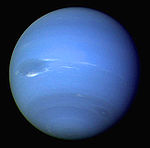- Laomedeia (moon)
-
Laomedeia Discovery [1][2] Discovered by - M.Holman
- JJ Kavelaars
- T. Grav
- W. Fraser
- D. Milisavljevic
Discovered August 13, 2002 Mean Orbital elements [3] Epoch 2003 Jun. 10.00 TT Semi-major axis 23.567 Gm Eccentricity 0.3969 Inclination 37.874° * Orbital period 3171.33 days
(8.68 yr)Physical characteristics Mean diameter 42 km[4] ** Rotation period ? Albedo 0.04 assumed[4] Color ? Spectral type ? *to the ecliptic **based on the albedo Laomedeia (
 /ˌleɪ.ɵmɨˈdiːə/ lay-o-mə-dee-ə or /ˌleɪ.ɵmɨˈdaɪ.ə/ lay-o-mə-dy-ə; Greek: Λαομέδεια), also known as Neptune XII, is a prograde irregular satellite of Neptune. It was discovered by Matthew J. Holman, et al. on August 13, 2002.[5] Before the announcement of its name on February 3, 2007 (IAUC 8802), it was known as S/2002 N 3.
/ˌleɪ.ɵmɨˈdiːə/ lay-o-mə-dee-ə or /ˌleɪ.ɵmɨˈdaɪ.ə/ lay-o-mə-dy-ə; Greek: Λαομέδεια), also known as Neptune XII, is a prograde irregular satellite of Neptune. It was discovered by Matthew J. Holman, et al. on August 13, 2002.[5] Before the announcement of its name on February 3, 2007 (IAUC 8802), it was known as S/2002 N 3.It orbits Neptune at a distance of about 23,571,000 km and is about 42 kilometers in diameter (assuming albedo of 0.04).[4] It is named after Laomedeia, one of the 50 Nereids.
References
- ^ JPL (2011-07-21). "Planetary Satellite Discovery Circumstances". Jet Propulsion Laboratory. http://ssd.jpl.nasa.gov/?sat_discovery. Retrieved 2011-10-24.
- ^ Green, Daniel W. E. (January 13, 2003). "Satellites of Neptune". IAU Circular 8047. http://www.cbat.eps.harvard.edu/iauc/08000/08047.html. Retrieved 2011-10-24.
- ^ Jacobson, R. A. (2008). "NEP078 – JPL satellite ephemeris". Planetary Satellite Mean Orbital Parameters. http://ssd.jpl.nasa.gov/?sat_elem. Retrieved 2009-09-23.
- ^ a b c Sheppard, Scott S.; Jewitt, David C.; Kleyna, Jan (2006). "A Survey for "Normal" Irregular Satellites around Neptune: Limits to Completeness". The Astronomical Journal 132: 171–176. arXiv:astro-ph/0604552. Bibcode 2006AJ....132..171S. doi:10.1086/504799.
- ^ Holman, M. J.; Kavelaars, J. J.; Grav, T. et al. (2004). "Discovery of five irregular moons of Neptune" (PDF). Nature 430 (7002): 865–867. Bibcode 2004Natur.430..865H. doi:10.1038/nature02832. PMID 15318214. https://www.cfa.harvard.edu/~mholman/nature_final.pdf. Retrieved 2011-10-24.
External links
- Neptune's Known Satellites (by Scott S. Sheppard)
- David Jewitt pages
- MPC: Natural Satellites Ephemeris Service
- Mean orbital parameters (NASA)[1]
Moons of Neptune Generally listed in increasing distance from NeptuneRegular (inner) Triton Irregular See also Neptune Discovery 
Characteristics - Rings
- Great Dark Spot
- Small Dark Spot
- The Scooter
- Kuiper belt
Moons Exploration Trojans Miscellaneous Categories:- Moons of Neptune
- Irregular satellites
Wikimedia Foundation. 2010.
